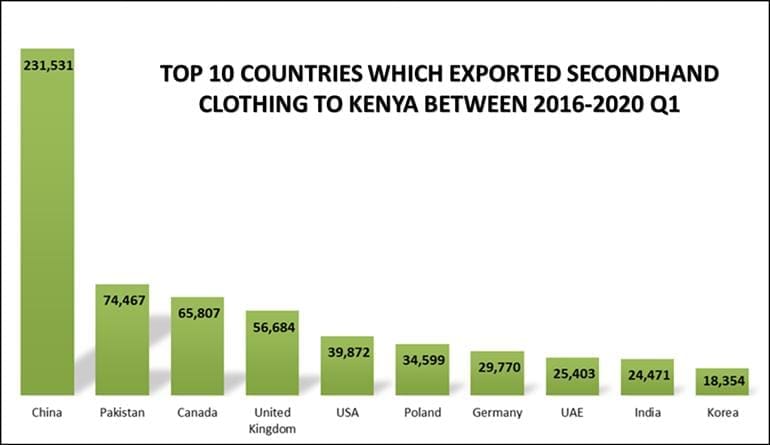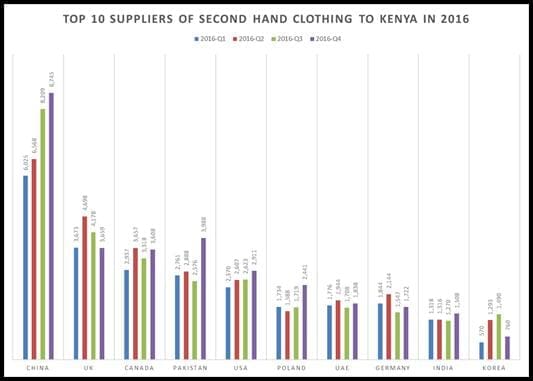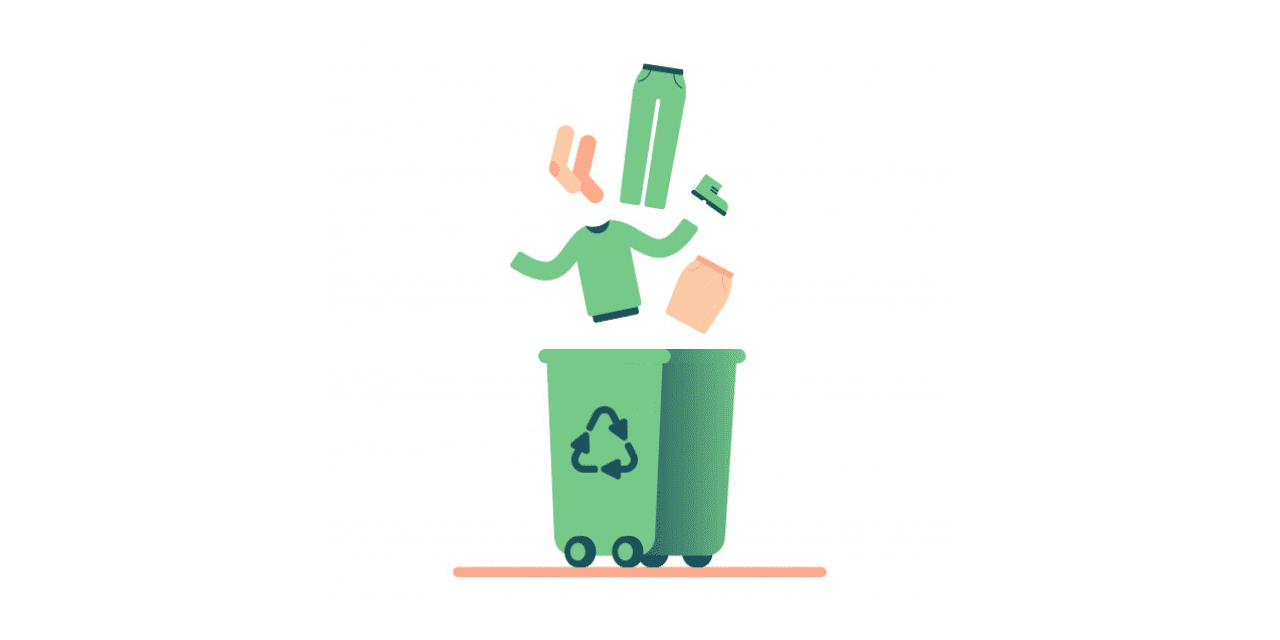Abstract
Most of those clothes are in fact donations from the US and Europe. More than 70% of all repurposed clothing in the UK is exported and sold. Approximately two million Kenyans work in the Mitumba market. Since the second-hand clothing industry and the formal textile industry are two distinct industries, players in those markets are not inherently competitors. In Kenya, these secondhand clothes are the lifeblood of every household. They have no class and are worn by almost all. Kenya not only imports used clothing for personal use, but also exports it to neighboring countries. Mitumba is not just a clothing culture in Kenya but it is a major source of income for numerous households there. Kenya imported the highest amount of secondhand clothing neither from USA nor Europe but from China between 2016-2020. As a result of its contribution to jobs and as a source of government revenue, the sector is critical to Kenya’s economy. The covid 19 pandamic has impacted Mitumba markets throughout the nation.
Introduction
Kenya is an East African country that is 29th most populated nation in the world. Kenyans have a special affinity for secondhand clothing. This culture of secondhand clothing is known as Mitumba or Mtumba. Mitumba literally translates to “bundles” in Swahili. Mitumba refers to second-hand clothing in Kenyan slang, with Gikomba being the most well-known marketplace. Kenyans are huge fans of secondhand clothing for a variety of reasons. For starters, they are one of the most cost-effective pieces of clothing. For as little as 20 shillings, or even 10 shillings, one may put on a pleasant piece of cloth. Two, they are long-lasting. Secondhand clothing outlasts new clothing, which is a reality that scientists will have to address in the future. Because of its use and export to other countries, Kenya is one of the largest importers of second-hand clothing in Sub-Saharan Africa, according to the report.
In six years, the nominal value of secondhand clothing imports into Kenya has increased by 80%, from 10 billion shillings to 18 billion shillings. Most households, according to a household analysis, buy new clothes when they are needed, such as for school or workplace uniforms. 91.5 percent of households purchase secondhand clothing worth less than 1000 shillings, while 8.5 percent purchase secondhand clothing worth more than 1000 shillings. 74.5 percent of all households purchased new clothing for less than 1000 shillings, while 25.5 percent purchased new clothing for more than 1000 shillings, demonstrating the price sensitivity of second-hand clothing.
People in countries such as the United Kingdom donate their old clothes to charity. People mistakenly assume that their contributions will be donated to those in need or sold in High Street charity shops to raise money, not realizing that their donations will be sold for profit in other countries. Kenya is without a doubt one of the main importers of used clothing in Sub-Saharan Africa. It also majorly contributes to generating a lot of revenue for the nation as well as helps in swelling per capita income.
Study of Kenya’s import of secondhand clothing between 2016-2020
Kenya is world’s largest importer of secondhand clothing. Figure 1 shows top 10 nations from where secondhand clothing was imported. Kenya imported 231,531 tons of secondhand clothes from China alone. This number was more than one third of the total import in the total span of 4 years and 3 months. India ranks 9th in this list with 24,471 tons of export of secondhand clothing to Kenya. Pakistan made to list of top 10 suppliers with 74,467 tons of export to Kenya which was more than Canada’s supply that stood in 3rd position with 65,807 tons of supply. UK and USA surprisingly were among top 10 suppliers with 4th and 5th position, respectively. The total export from USA and UK combined was less than half export from China. Poland, Germany, and UAE were among other top 10 suppliers to Kenya.

The top 10 suppliers had a varied supply between 2016-2020. China’s supply was more than double in 2018 and 2019 when compared with the supply of 2016. Every country supply in 2020 was low as Kenya had banned import of secondhand clothing since March 2020 due to Covid 19 pandemic. China, Pakistan, Canada, USA, Poland, and Germany’s supply swollen up in 2019 and was highest among 5 years. Canada and Pakistan’s export increased with every passing year. UK’s supply decreased consecutively every passing year. India’s supply was highest in 2019 among all its supply in the 5 years.

In 2016, China was the leading supplier of secondhand clothing to Kenya. Its total supply summed up to 29,548 tons in 2016 and its highest supply in the whole year was in the 4th quarter. China was further followed by UK and Canada with 12,212 and 13,520 tons of supply, respectively. India was 9th largest supplier and Korea was 10th. Korea’s supply of secondhand clothing increased in every quarter of 2016 but fell drastically from 1,490 to 760 tons. Pakistan’s supply was noticeably high in the 4th quarter of 2016 landing it in the fourth position. UAE’s total supply for the same year was just 10 tons more than Germany’s total supply for that year.

This statistic belongs to the same year, when secondhand clothing import was under the discussion for suspension. Burundi, Kenya, Rwanda, Tanzania, and Uganda make East Africa Community (EAC). EAC had proposed a ban on import of secondhand clothing to boost local manufacturing, help economy and prevent local textile industry from shutting down. The other reason behind the proposal of this ban was hygiene, EAC claimed that importing used clothes is unhealthy and has no sanitary standards. Eventually, this proposal was rejected, and Kenya continued to import secondhand clothing from various countries.
 In 2017, the import swollen up by 2,947 tons than the previous year. Total import in the year 2017 was 1,32,565 tons from which 40,681 was China’s supply making it the highest supplier for the same year. China’s highest supply was in the fourth quarter for the same year. The growth in total annual import of secondhand clothing was notably less as due to previous year’s EOC’s proposal of ban on secondhand clothing import. EOC had not banned it but the imports curbed for the sake of dignity, development, and hygiene. While the ban was being debated back then, it was concluded that East Africa still was dependent on America for a lot of things and was not in a state to say, ‘We do not need you anymore’. Thus, the idea about the ban was suspended. In the same year, UK’s position on the top suppliers list dropped to 4th and Canada and Pakistan’s rank shifted to 2nd and 3rd respectively with the annual supply of 14,890 and 14,385 tons, respectively. A constant drop was witnessed in UK’s and USA’s supply in every quarter of the year. India climbed up to 8th position with 5,577 tons of supply in the same year. Unlike previous year, Korea had maintained 10th position in the list. Korea’s supply was 1,187 tons less than UAE’s supply. Germany’s supply summed up to 5,647 tons, with the highest supply in the first quarter of the year. Even Poland’s highest supply was in the first quarter for the same year.
In 2017, the import swollen up by 2,947 tons than the previous year. Total import in the year 2017 was 1,32,565 tons from which 40,681 was China’s supply making it the highest supplier for the same year. China’s highest supply was in the fourth quarter for the same year. The growth in total annual import of secondhand clothing was notably less as due to previous year’s EOC’s proposal of ban on secondhand clothing import. EOC had not banned it but the imports curbed for the sake of dignity, development, and hygiene. While the ban was being debated back then, it was concluded that East Africa still was dependent on America for a lot of things and was not in a state to say, ‘We do not need you anymore’. Thus, the idea about the ban was suspended. In the same year, UK’s position on the top suppliers list dropped to 4th and Canada and Pakistan’s rank shifted to 2nd and 3rd respectively with the annual supply of 14,890 and 14,385 tons, respectively. A constant drop was witnessed in UK’s and USA’s supply in every quarter of the year. India climbed up to 8th position with 5,577 tons of supply in the same year. Unlike previous year, Korea had maintained 10th position in the list. Korea’s supply was 1,187 tons less than UAE’s supply. Germany’s supply summed up to 5,647 tons, with the highest supply in the first quarter of the year. Even Poland’s highest supply was in the first quarter for the same year.
2018, witnessed a rise of 44 thousand tons in the supply which was a lofty change. China was still on the top with the total supply of 74 thousand tons. There was a subsequent growth in China’s supply for the first three quarters which drastically reduced in the last quarter. Pakistan climbed up to 2nd position with the annual supply of 19 thousand tons. India’s supply was 621 tons more than the previous year’s supply. USA and Poland’s supply increased consecutively each after every quarter. China, Canada, UK, India, and Korea’s highest supply were in the third quarter from all the four quarters.
the total supply of 74 thousand tons. There was a subsequent growth in China’s supply for the first three quarters which drastically reduced in the last quarter. Pakistan climbed up to 2nd position with the annual supply of 19 thousand tons. India’s supply was 621 tons more than the previous year’s supply. USA and Poland’s supply increased consecutively each after every quarter. China, Canada, UK, India, and Korea’s highest supply were in the third quarter from all the four quarters.
According to a study released by the Mitumba Association of Kenya in collaboration with the Institute of Economic Affairs, Kenya imported 185,000 tons of used clothing in 2019. This equated to around 8,000 containers. Import taxes increased to $15,000 per 40-foot container in 2019. (equivalent to 24 tons).
In 2019, Kenya imported 185,000 tons of used clothes, which equates to around 8,000 containers. The total amount of taxes collected was 12 billion shillings. The secondhand clothing industry generates at least 1 billion shillings in monthly sales. Traders must also pay business license fees, as well as other taxes to the federal and state governments. Just like every year, China was the leading supplier in 2019 as well. Its highest supply was in the second quarter. China’s Supply summed up to 74,327 tons for the whole year. Pakistan was the second largest supplier with 22,332 tons of supply of secondhand clothing to Kenya. Canada’s supply was worth 16,943 which kept swelling up consecutively till the third quarter and then a substantial reduction was seen in the supply of fourth quarter. India was 8th in this list with the total supply of 5,737 tons.
Impact of Mitumba on local textile industry
Clothing accounts for 2.5 percent of overall private consumption in Kenya, or 197.5 billion shillings. This equates to an average of 4,150 shillings spent per person on all clothing and footwear purchases. The formal textile industry and the mitumba sector are two separate entities. The formal Kenyan textile industry includes yarn and clothing production, as well as research and development, design, manufacturing, and distribution. Mitumba is a business that buys and sells used clothing. As a result, there is a significant price difference between the two brands, with used clothing being considered less expensive.
 Most households purchase new clothing, such as uniforms, when they have no other choice, according to a household study. Kenyans have not given up on buying new clothes, particularly in the colder months like December.
Most households purchase new clothing, such as uniforms, when they have no other choice, according to a household study. Kenyans have not given up on buying new clothes, particularly in the colder months like December.
According to the Kenya National Bureau of Statistics, the gross private consumption in the Kenyan economy is 7.9 trillion shillings. Clothing accounts for 2.5 percent of overall private consumption in Kenya, or 197.5 billion shillings. This equates to an average of 4,150 shillings spent per person on all clothing and footwear purchases (both new and second-hand purchases).
Mitumba ban in Kenya and its impact
During onset of covid 19 pandemic, mitumba was banned in Kenya. This ban had affected all the people who directly and indirectly were employed in mitumba business. Import of secondhand clothing was suspended in end of March 2020 and could resume after mid-August in the same year. According to the import policy of Kenya, mitumba imports are required to be accompanied by a health certificate issued by a public health authority in the country of origin. Consignments must also be packaged in clear transparent materials at a maximum weight of 50kg for clothes and 25kg for shoes. The government has been keen to discourage importation of second-hand clothes in favor of the local textile industry. Mitumba’s high quality and relatively low prices, on the other hand, continue to fuel demand for the product, which is favored primarily by the lower and middle classes. The country imported 177,160 tons of mitumba in 2018 valued at about Sh17 billion, according to the Kenya National Bureau of Statistics, up from 135,868 tons in 2017.
Imports have however dropped as global supply chains remain affected, amid a trade downtime in the wake of the Covid-19 crisis.
Job losses
Around 2,000,000 Kenyans are employed directly by the mitumba sector, with many more employed indirectly. Mitumba traders, who import used clothes in bulk and supply to retailers, who then sell the clothes on the market, are among those directly employed by the industry. These individuals hire other Kenyans in the transportation industry to transport the goods, as well as funds to fix or change the clothing before selling it, and others to clean and iron it. It is essentially a long chain of people who have benefited from this industry and have now lost their jobs because of the ban. One must wonder how these people can survive when the economy is on the verge of collapse due to the Covid-19 pandemic.
Loss of respectability
Mitumba has given the common man dignity by allowing them to afford quality clothing since its introduction in the 1980s. Our parents used to tell us stories of how they went to school without shoes and made it through amid the difficulties as a motivator for us to work hard. According to a conversation I saw on social media, the key reason they did not have shoes was because their parents could not afford a new pair. In other words, a person who cannot afford to spend Ksh. 1,000 on a new pair of shoes will not be able to afford them if the option of buying a used pair for 300 bob is removed. Most possibly, the person will continue to wear his or her old pair of shoes until they are ripped and worn out.
Taxes not paid
We are one of the most heavily taxed countries on the planet, which means that you are most likely paying one or more taxes for every purchase you make. The mitumba bales are taxed when they arrive in the country. When the traders go to the market to sell their products, they must pay fees to their respective county governments. Our government is funded by the taxes we pay, and I believe that every shilling goes to the taxman’s pocket. As a result, the loss of taxes would have an effect, particularly because the economy has been severely harmed by the Covid-19 pandemic.
Degradation of the environment
We live in a highly polluted environment that has resulted in global warming, the consequences of which can be seen in the recent changes in weather patterns. As a result, we must do our part to help reduce waste by reusing and recycling products. The purchasing of secondhand clothing and accessories is part of a cycle of reusing products that would otherwise be discarded in a landfill, polluting the atmosphere. So, while doing your part to protect the world, do not let anyone make fun of you.
By:
RADHIKA BODDU
KSHIPRA GADEY

